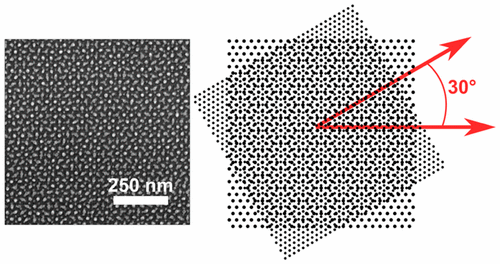March 20, 2017 report
Moire superstructures created using block copolymers

Bob Yirka
news contributor

(Â鶹ÒùÔº)—A team of researchers at the University of Alberta has developed a way to create moiré superstructures using block copolymers. In their paper published in the journal ACS Nano, the team describes the technique, the ways it can be modified and possible uses for the end product.
To create ever-smaller devices, scientists have continued to look for new fabrication methods that can be used to manipulate materials at the nanoscale. One avenue of research is block copolymer (BCP) self-assembly—a means for creating patterns on extremely small nanostructures. BCPs have more than one chemically distinct polymer chain—they are connected by covalent bonds. Researchers tune attributes such as chemical composition, molecular weight and volume to cause them to self-assemble into repeating patterns. It has also been found that directed self-assembly of BCPs can be used to build templates for creating patterns that are beyond the resolution of conventional lithography. In this new effort, the researchers used a four-step process to apply the directed self-assembly of BCPs to create moiré superstructures.
Moiré patterns are interference patterns created when an opaque ruled pattern with see-through gaps is laid over another similar pattern. Superstructures are structures that emerge when one structure is superimposed on another. In this effort, the team combined the two ideas to create structures with multi-micron sized grains with preferred majority phases.
The team used self-formation to create a thin film BCP layer as a base using spin coating. Next, they applied solvent annealing and reactive ion etching to turn the initial layer into a hexagonal lattice of silica dots. They then repeated the process on top of the first layer using a different BCP with the lattice spaced differently. Adding the top layer resulted in converting the BCP to silica dots, which in return resulted in the creation of a moiré superstructure.
The researchers note that they are not yet clear on how such structures might be used in an application, but suggest they might prove useful for creating metasurfaces with tunable optical properties. They note the structures can be modified by changing dot size and height and pitch ratio.
Written for you by our author —this article is the result of careful human work. We rely on readers like you to keep independent science journalism alive. If this reporting matters to you, please consider a (especially monthly). You'll get an ad-free account as a thank-you.
More information: Cong Jin et al. Preferential Alignment of Incommensurate Block Copolymer Dot Arrays Forming Moiré Superstructures, ACS Nano (2017).
Abstract
Block copolymer (BCP) self-assembly is of great interest as a cost-effective method for large-scale, high-resolution nanopattern fabrication. Directed self-assembly can induce long-range order and registration, reduce defect density, and enable access to patterns of higher complexity. Here we demonstrate preferential orientation of two incommensurate BCP dot arrays. A bottom layer of hexagonal silica dots is prepared via typical self-assembly from a PS-b-PDMS block copolymer. Self-assembly of a second, or top, layer of a different PS-b-PDMS block copolymer that forms a hexagonal dot pattern with different periodicity results in a predictable moiré superstructure. Four distinct moiré superstructures were demonstrated through a combination of different BCPs and different order of annealing. The registration force of the bottom layer of hexagonal dots is sufficient to direct the self-assembly of the top layer to adopt a preferred relative angle of rotation. Large-area helium ion microscopy imaging enabled quantification of the distributions of relative rotations between the two lattices in the moiré superstructures, yielding statistically meaningful results for each combination. It was also found that if the bottom layer dots were too large, the resulting moiré pattern was lost. A small reduction in the bottom layer dot size, however, resulted in large-area moiré superstructures, suggesting a specific size regime where interlayer registration forces can induce long-range preferential alignment of incommensurate BCP dot arrays.
Journal information: ACS Nano
© 2017 Â鶹ÒùÔº



















